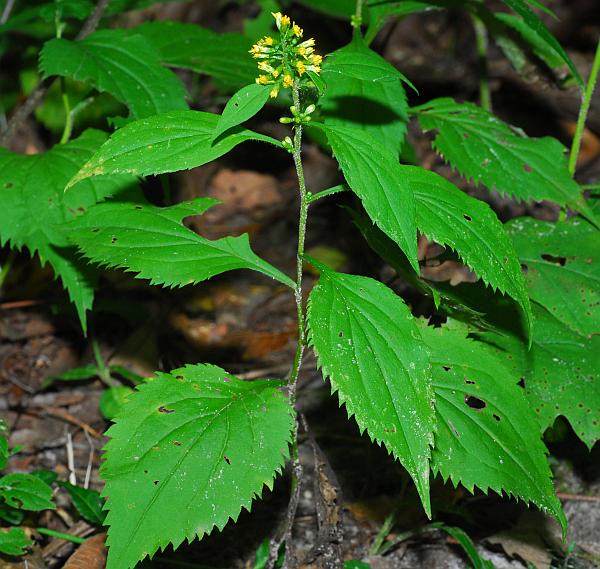Solidago flexicaulis L.
Broadleaf Goldenrod

Native
CC = 7
CW = 3
MOC = 46
© SRTurner
Solidago flexicaulis L.Broadleaf Goldenrod | |
 |
Native CC = 7 CW = 3 MOC = 46 |
© SRTurner |
|
Family - Asteraceae/Astereae Habit - Perennial forb with long, slender, branched rhizomes. Stems - Loosely ascending to erect, to 1.2 m, usually solitary, noticeably angled and ridged, often zigzag especially toward the tip, glabrous below the inflorescence (the inflorescence branches moderately pubescent with curved hairs), sometimes slightly shiny, not glaucous.
Leaves - Chiefly cauline, the largest leaves in the lower 1/3-1/2 of the stem, the basal leaves absent at flowering. Basal and lowermost stem leaves with the blade 7-15 cm long, 3-10 cm wide, mostly 1-2 times as long as wide, broadly ovate, relatively thin, rounded then tapered abruptly at the base to a relatively long, winged petiole, short-tapered to a sharply pointed tip, the margins sharply toothed and usually inconspicuously hairy, the upper surface glabrous, the undersurface sparsely to moderately pubescent with short, spreading hairs, with 1 main vein, the fine, pinnate secondary veins relatively easily observed (these usually forming an irregular network). Median and upper stem leaves 1-10 cm long, the uppermost leaves sometimes lanceolate to narrowly elliptic and with the margins entire or nearly so, otherwise similar to the lower stem leaves.
Inflorescences - Axillary clusters grading into a narrow, racemose panicle, the heads oriented in several directions when short ascending branches are present.
Heads - Involucre 4-6 mm long, the bracts in 3-5 unequal series. Involucral bracts mostly narrowly oblong and rounded to bluntly pointed at the appressed-ascending tip, the thin, white to yellowish white margins hairy toward the tip, the outer surface glabrous. Receptacle naked.
Florets - Ray florets 3-5, the corollas 2.5-5.0 mm long, yellow. Disc florets 5-9, the corollas 3-5 mm long, the lobes 0.9-1.2 mm long, yellow. Pappus 2-3 mm long, a few of the bristles often slightly thickened toward the tip.
Fruits - Achenes 1.5- 2.0 mm long, narrowly obovoid, finely hairy. Flowering - July - October. Habitat - Bottomland forests, bluff bases, north-facing slopes. Origin - Native to U.S. Lookalikes - Other goldenrods, especially S. arguta. Other info. - This plant is scattered across much of Missouri, less commonly toward the west. In fact, Missouri is at the western edge of the plant's natural range, which otherwise extends north and east from the state. S. flexicaulis is one of the more easily recognized goldenrods, having broad, coarsely toothed leaves with winged petioles, and cylindrical inflorescences. The rich, moist, shaded habitat is also a strong clue to identity. The specific epithet flexicaulis means "bent stem," referring to the typical zigzag aspect of the stem. This trait is variable. Photographs taken at the Porcupine Mountains, Michigan, 9-7-03 (DETenaglia); also at LaBarque Creek Conservation Area, Jefferson County, MO, 9-13-2012 (SRTurner). |